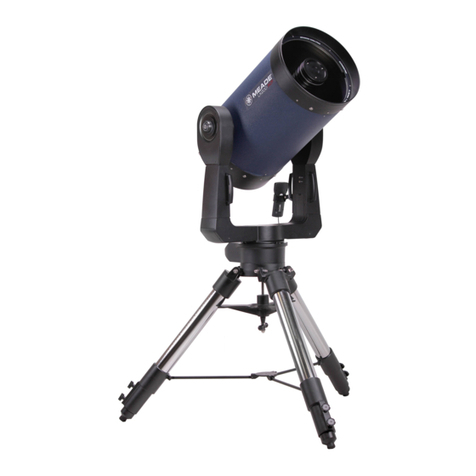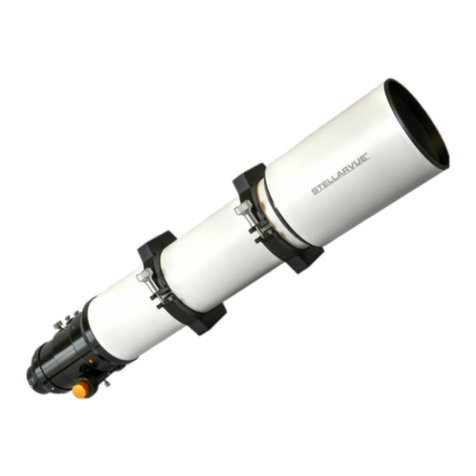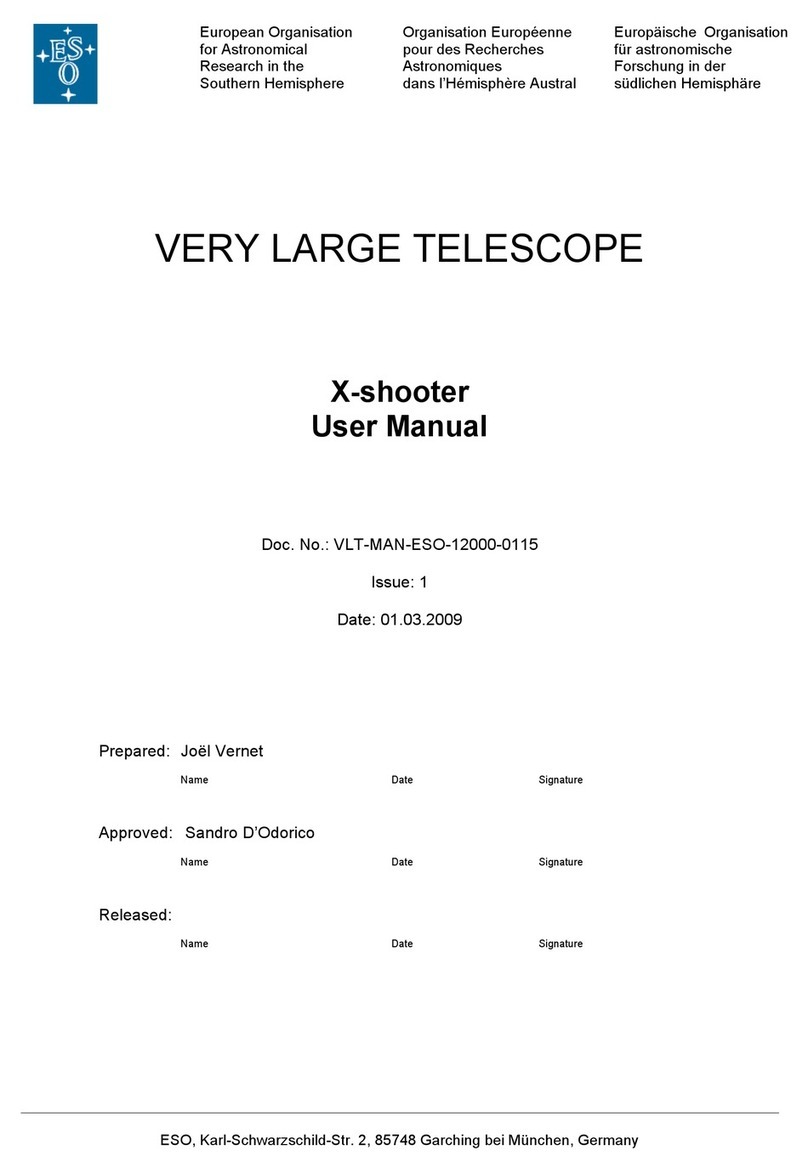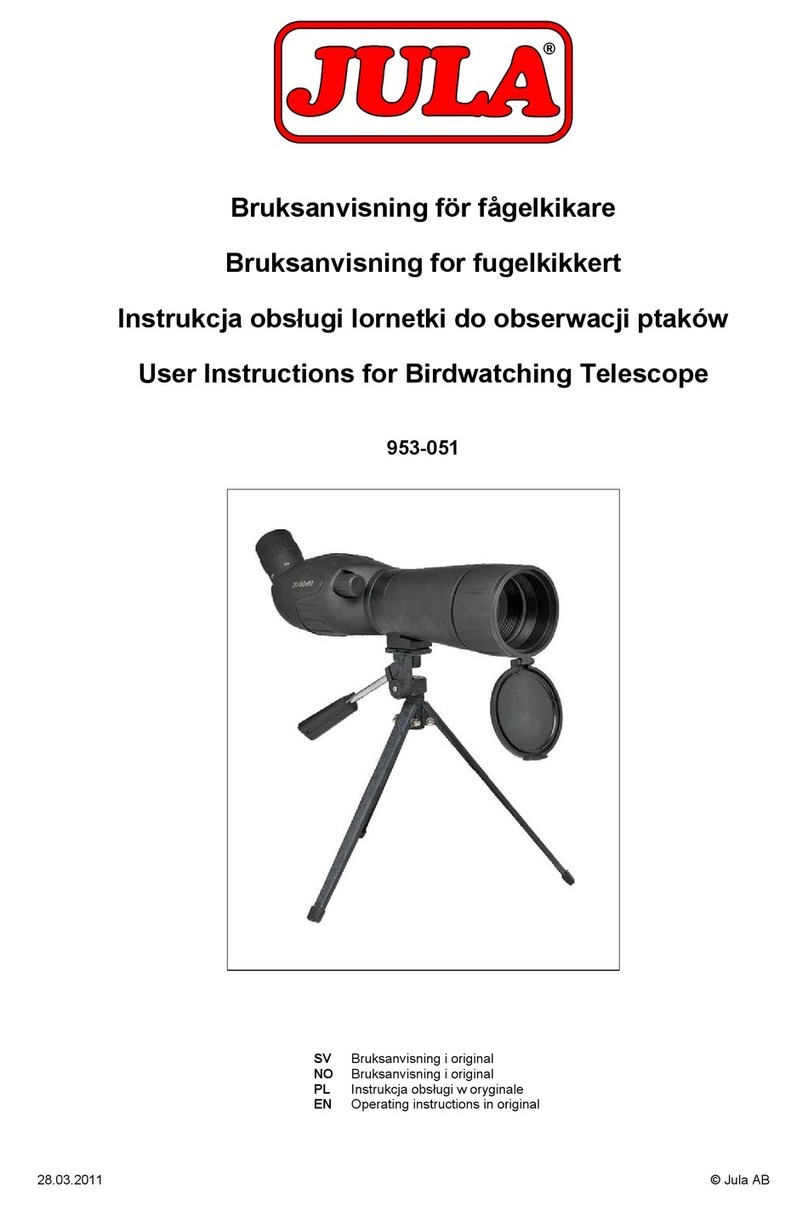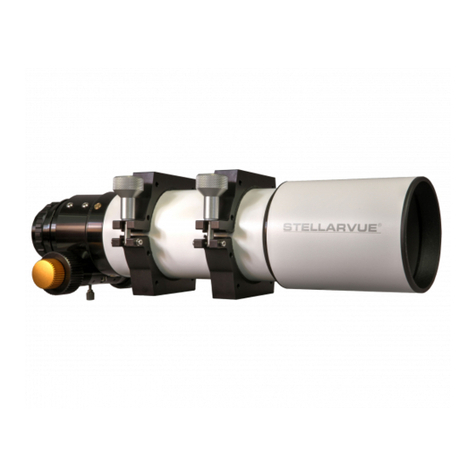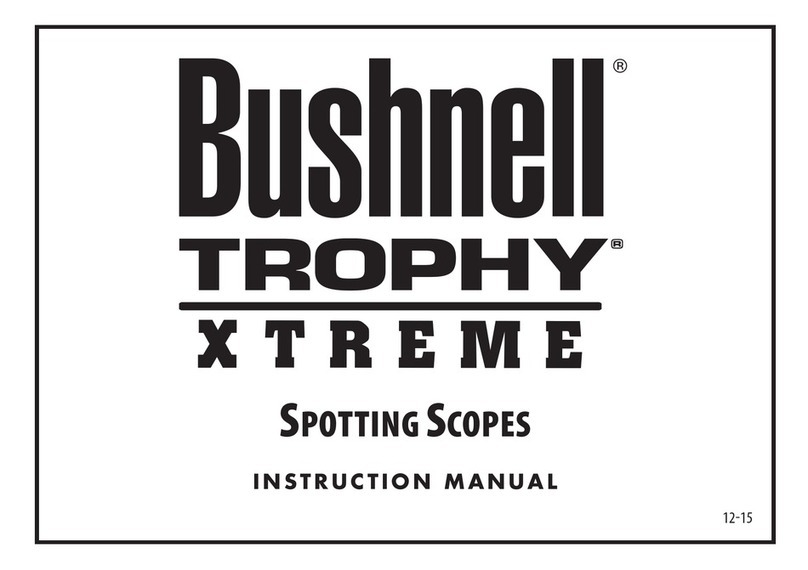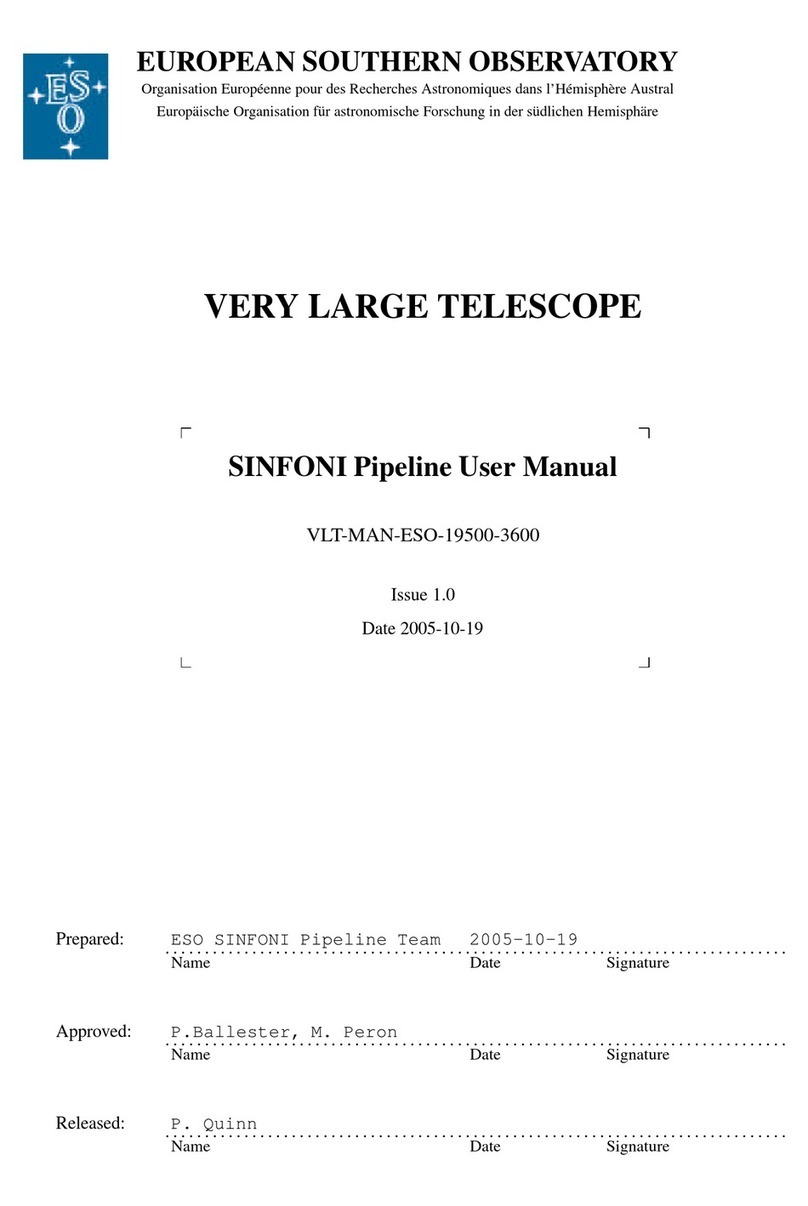BINTEL BT 152 User manual

1
INSTRUCTION MANUAL
THE BINOCULAR AND TELESCOPE SHOP
84 Wentworth Park Rd Gle e NSW 2037
519 Burke Rd Cam erwell VIC 3124
Email: info@ intel.com.au
WWW: www. intelshop.com.au & www. intel.com.au
BINTEL TELESCOPES
DOBSONIAN TELESCOPES

2
Congratulations and thank you for selecting a uality Bintel telescope. Your new Bintel Dobsonian is designed
for high-resolution viewing of astronomical objects. With its precision optics and Dobsonian mount, you’ll be
able to locate and enjoy thousands of fascinating celestial denizens, including the planets, Moon, and a variety
of deep-sky galaxies, nebulas, and star clusters. If you have never owned a telescope before, we would like to
welcome you to amateur astronomy. Take some time to familiarize yourself with the night sky. Learn to
recognize the patterns of stars in the major constellations. With a little practice, a little patience, and a
reasonably dark sky away from city lights, you’ll find your telescope to be a never-ending source of wonder,
exploration, and relaxation.
For after sales service or friendly advice contact Bintels Service Dept.
Our ualified technical and astronomy staff will be happy to help.
These instructions will help you set up, properly use and care for your telescope.
Please read them over thoroughly before getting started.
Finderscope
Spring Loaded Self Adjuster
Alignment Screws
Finder Brackets
Optical Tube Assembly
Crayford Focuser
with 10:1 Microfocus
2” - 1.25” Adapter
Focuser Knob
Left Side Panel
Ground Board
Top Baseplate
Altitude Bearing
With Braking System
Primary
Mirror Cell
Cooling Fan
Parts of a Bintel Dobsonian
Bintel Label
Your Guarantee of Quality
Eyepiece Rack
Carry Handle

3
Ta le of Contents
1. Overview
…………………………………………………………………………………………………………………………….…………………………..
2
2. Unpacking and Parts List
………………………………………………………………………………………………………….………………...
3
3. Base Assembly
.……………………………………………………………………...……………………..…………………………………………...…
4
3. Using Your Telescope
……………………………………………………………………………………………………….…………...…………..
6
4. Collimation (Aligning the Mirrors)
……………………………………………………………………………………..……………..………
9
5. Astronomical Observing
……………………………………………………………………………………………...…………..…….…………
11
6. Care and Maintenance
…………………………………………………………………………………………………..………………….……...
15
7. Specifications (BT 202 and BT 252)
……………………………………………………………………….……………..………………
15
8. Specifications (BT 302)
……………………………………………………………………………………………….……………..….………….
16
9. Suggested Accessories
………………………………………………………………………………...……………………………..…………...
16
10. Warranty
………………………………………………………………………………………………………...……………..…….…………………...
16
2. Unpacking
The telescope will arrive in two boxes.
The larger box contains the optical tube assembly and accessories.
The Large flat pack contains the unassembled Dobsonian base and hardware.
Below is a packing slip for both boxes.
When unpacking the boxes please be careful as there are some small parts that could easily become lost.
We suggest that this be done indoors. We recommend keeping the original shipping containers. In the event
that the telescope needs to be shipped to another location, or returned to Bintel for warranty repair, having
the proper shipping containers will help ensure that your telescope will survive the journey intact.
Make sure all the parts in the Parts List below are present. Be sure to check boxes carefully, as some parts
are small.
If anything appears to be missing or broken, call Bintel Customer Support (02) 9518 7255 for assistance.
Box #2: Do sonian Base
Qty. Description
1 Left panel
1 Right panel
1 Front brace
1 Top baseplate (has countersunk holes in it)
1 Ground baseplate
2 Metal disks
1 Roller Bearing Mat
1 Aluminium Tube (sleeve between top and
bottom baseplates)
Hardware Pack
1 Eyepiece rack
2 Eyepiece rack mounting wood screws
(length 3/4")
1 Handle
2 Socket-head cap screws, 5/16" (black)
1 Large Allen wrench (6mm)
8 Base assembly screws (length 2")
(BT 202 / BT252)
12 Base assembly screws (length 2") (BT 302)
1 Small Allen wrench (size 4mm)
3 Plastic feet
3 Feet attachment wood screws (length 1")
1 Large hex-head bolt (length 3")
Parts List
Box #1: Optical Tu e Assem ly and Accessories
Qty. Description
1 Optical tube assembly
1 Dust cover
1 26mm Bintel Wide Angle eyepiece 2” barrel
(all models)
1 15mm Bintel Plossl eyepiece 1.25” barrel
diameter (all models)
1 9mm Bintel Plössl eyepiece, 1.25" barrel
diameter (all models)
1 Right Angled 8 x 50 finder scope
1 Finder scope bracket with O-Ring
1 Moon Filter
1 Instruction Manual
2 Altitude Bearings with Braking System
WARNING:
Never look directly at the Sun through
your telescope or its finder scope—
even for an instant—without a
professionally made solar filter that
completely covers the front of the
instrument, or permanent eye damage
could result. Young children should
use this telescope only with adult
supervision.

4
2. Assem ly
Now that you have unpacked the boxes and
familiarized your-self with all the parts in front of
you, it’s time to begin assembly.
Start with the Base.
Assem ly of the Do sonian ase
The base need only be assembled once, unless you
disassemble it for long-term storage. The assembly
process takes about 15 minutes and re uires,
an adjustable crescent wrench, and the provided
Allen wrenches.
1. Loosely attach the front oard to the two side
panels with four of the base assembly screws (I) in
the predrilled holes. Use the Allen wrench to tighten
the screws. Do not completely tighten the screws
yet.
(See image at right)
2. Assem ly
Now that you have unpacked the boxes and
familiarized your-self with all the parts in front of
you, it’s time to begin assembly.
Start with the Base.
Assem ly of the Do sonian ase
The base need only be assembled once, unless you
disassemble it for long-term storage. The assembly
process takes about 15 minutes and re uires,
an adjustable crescent wrench, and the provided
Allen wrenches.
1. Loosely attach the front oard to the two
side panels with four of the base assembly
screws in the predrilled holes. Use the Allen
wrench to tighten the screws. Do not com-
pletely tighten the screws yet. (See image be-
low) Note: Be sure that the Predrilled holes
for the eyepiece rack are on the LEFT of the
rocker box. (as view from the rear).
The Threaded inserts on the Front Brace are
on the inside.
2. Turn this assembly upside down, and screw on
the top of the base board. Continue using the large ,
hex-head screws . (See image Below)
Once all base hex head screws are in place tighten
them with Allen Wrench.
3. Screw the 3 feet into the small pre drilled holes
on the bottom of the ground board with a Phillips
head screw driver
Ground oard with Metal disks and
Roller Bearing fitted
4. With the rocker box still upside down, Place the
Roller Bearing Mat between the two metal disks.
Put the aluminium spacer tube into the bottom of
the rocker box and put the metal disks and bearing
mat over the spacer tube. Now put the Ground
board on with the spacer tube coming through it.
The captive T-Nut should be on the top (at this time)
The 3 rubber feet should be on the top.
Now using Pivot Bolt screw it through the aluminium
spacer tube from inside the rocker box and tighten.
There is a fixed T-screw in the bottom of the ground
board to secure it all.
Note: The Pivot Bolt has a Roller Bearing in it
Do Not over tighten. LARGE Washer on ottom.
Small Washer etween Roller Bearing and
Plastic Kno .

5
Optical Tu e Assem ly
We are now ready to assemble the tube section of
the telescope. First unpack the parts re uired and
set aside.
1. Take Tube Assembly out of box and stand
upright with sitting on the ground.
2. The Side Bearing Kit must be installed.
This comes in two brown boxes inside the
Accessories Box. (see image at right)
Altitude Bearing
with uilt -in Break-
ing Sys- tem
3. With the telescope standing in the upright
position. The side bearing housing is visible and it
contains both a Scale and Two (2) Small Brass Nuts
with Phillips Head Screws protruding from them.
Altitude Bearing
Housing with Brass
Nuts
4. Re- move Phil-
lips Head Screws and place Altitude Bearing in posi-
tion so that the screws will screw into the Brass
Nuts.
Altitude Bearing
Fitted
5. One side panel has 2 small pre-drilled holes for
mounting the Eyepiece Rack. Attach the Eyepiece
Rack with its screws. (see image below)
6. At- tach the
handles to the Front Brace with the socket-head
screws. Insert the screws through the handle and
into the predrilled holes. Fit the nuts at the rear of
the front panel. Tighten the bolts with an Allen
wrench. Note: Be sure that the threaded inserts
are on the inside of the rocker box.
Attach the handle to the front panel with the two
black socket-head screws. Insert the screws through
the handle and into the predrilled holes.
Fit the nuts at the rear of the front panel. Tighten
the bolts with an Allen wrench. (see image below)
\
Front Handle
Your Rocker
Box should
now be complete and look like the image below.

6
3. Using Your Telescope
It is best to get a feel for the basic functions of the
Bintel Dobsonian during the day, before observing
astronomical objects at night. This way you will not
have to fumble around trying to orient yourself in
the dark! Find a spot outdoors where you have plen-
ty of room to move around the telescope, and where
you have a clear view of some object or vista that is
at least 1/4-mile away. It is not critical that the base
be exactly level, but it should be placed on some-
what flat ground or pavement to ensure smooth
movement of the telescope. Remember, never point
the telescope at or near the Sun without using a
proper solar filter over the front aperture!
Altitude and Azimuth
The base of the Bintel Dobsonian permits motion of
the telescope along two axes: altitude (up/down)
and azimuth (left/right) (see Figure 8). This is very
convenient, since up/down and left/right are the
most “natural” ways that people aim. As a result,
pointing the telescope is exceptionally easy.
Simply take hold of the telescope tube and move it
left or right so the base rotates about its central
azimuth bolt, and move it up or down so the altitude
side bearings rotate in the base’s cradle.
Both motions can be made simultaneously and in a
continuous manner for easy aiming. Move the
telescope gently - let it glide. In this way you can
point the telescope to any position in the night sky,
from horizon to horizon. When moving he telescope,
it may be convenient to grasp the front end of the
telescope tube so that your fingers just protrude into
it; this provides a convenient “handle”.
The Bintel Do sonian has two axis of motion:
Altitude (up/down) and Azimuth (left/right)
Installing the Finder Scope
The Bintel Dobsonians come with a high uality,
Right Angled 8x50 achromatic finder scope.
This greatly aids in finding objects to view in the
night sky. The “8” means it magnifies 8 times, the
“50” means it has a 50mm diameter lens. It shows
around 5 degrees of sky. Before attaching the finder
scope bracket to the telescope tube, it is convenient
to first install the finder in the bracket. Thread the
two finder scope alignment thumb screws (with
knurled lock nuts attached) into the holes on the
outside of the finder bracket’s rings. Pull the spring
loaded adjuster out to enable you to slide the finder
scope through the bracket’s rings and secure it in
place with the alignment thumb screws; make sure
the knurled lock nuts are ade uately loosened to do
this. The finder scope should be oriented within the
finder bracket as shown in Figure 6. Now, connect
the entire assembly to the telescope. Do this by first
removing the round knurled nuts on the two thread-
ed bolts adjacent to the focuser. Then position the
holes in the base of the finder bracket over the bolts,
and secure the bracket in place with the two round
nuts. The large (objective) end of the finder scope
should be pointing toward the front (open) end of
the telescope tube.
Inserting an Eyepiece
The final step in the assembly process is to insert an
eye-piece into the telescope’s focuser. Take the cov-
er cap off the end of the focuser drawtube. Loosen
the thumb screw on the 1.25" eyepiece adapter. Do
not loosen the two thumb screws on the 2" eyepiece
adapter. Insert one of the supplied eyepieces, then
secure it by retightening the thumbscrew on the
1.25" eyepiece adapter. The other eyepiece can be
placed in the eyepiece rack until it is needed. The
assembly of your Bintel Do sonian is now com-
plete. It should appear as shown on page 2. The
dust cap on the front of the telescope tube should
always remain in place when the telescope is not in
use. It is also a good idea to store eyepieces in an
eyepiece case and to replace the cover caps on the
focuser and finder scope when the telescope is idle.
Right Angled 8x50 finder scope and racket.
Eyepiece eing fitted to telescope

7
Viewing with Eyeglasses
If you wear eyeglasses, you may be able to keep
them on while you observe, if your eyepieces have
enough eye relief to allow you to see the whole field
of view. You can try this by looking through the
eyepiece first with your glasses on and then with
them off, and see if the glasses restrict the view to
only a portion of the full field. If they do, you can
easily observe with your glasses off by just
refocusing the telescope the needed amount.
If you suffer from severe astigmatism, however, you
may find images noticeably sharper with your glass-
es on point you want to look at. Then look through
the telescope’s eyepiece to see if that point is cen-
tered in the field of view. If it is, the job is done. If
not, make the necessary adjustments
Aligning the Finderscope
The finder scope must be aligned accurately with the
telescope for proper use. To align it, first aim the
main telescope in the general direction of an object
at least 1/4-mile away -the top of a telephone pole,
a chimney, etc. Position that object in the center of
the telescope’s eyepiece.
Now, look in the finderscope. Is the object visible?
Ideally, it will be somewhere in the field of view. If it
is not, some coarse adjustments of the two
finderscope alignment thumb screws will be needed
to get the finderscope roughly parallel to the main
tube. With the image in the finderscope’s field of
view, you will now use the alignment thumb screws
to center the object on the intersection of the
crosshairs.
By loosening one alignment thumb screw and
tightening another you change the line of sight of
the finderscope. Continue making adjustments to the
various alignment thumb screws until the image in
both the finder scope and the telescope’s eyepiece is
exactly centered. Check the alignment by moving
the telescope to another object and fixing the
finderscope’s crosshairs on the exact point you want
to look at.
Then look through the telescope’s eyepiece to see if
that point is centered in the field of view. If it is, the
job is done. If not, make the necessary adjustments
until the two images match up. The finderscope
alignment needs to be checked before every
observing session. This can easily be done at night,
before viewing through the telescope. Choose any
bright star or planet, center the object in the tele-
scope eyepiece, and then adjust the finderscope’s
alignment thumb screws until the star or planet is
also centered on the finder’s crosshairs.
The finderscope is an invaluable tool for locating
objects in the night sky; its usage for this purpose
will be discussed later., in detail.
Focusing the FinderScope
If, when looking through the finderscope, the images
appear somewhat out of focus, you will need to
refocus the finderscope for your eyes. Loosen the
lock ring located behind the objective lens cell on the
body of the finderscope Back the lock ring off by a
few turns, for now. Refocus the finderscope on a
distant object by threading the objective lens cell in
or out on the finderscope body. Precise focusing will
be achieved by focusing the finderscope on a bright
star. Once the image appears sharp, retighten the
lock ring behind the objective lens cell. The finder
scope’s focus should not need to be adjusted again.
Aiming/Pointing the Telescope
With the finder scope aligned, the telescope can be
uickly and accurately pointed at anything you wish
to observe. The finderscope has a much wider field
of view than the telescope’s eyepiece, and therefore
it is much easier to first center an object in the find-
er scope. Then, if the finderscope is accurately
aligned, the object will also be centered in the tel-
escope’s field of view.
Start by once again moving the telescope until it is
pointed in the general direction of the object you
want to see. Some observers find it convenient to
sight along the tube to do this. Now, look in the
finderscope. If your general aim is accurate, the
object should appear somewhere in the field of view.
Make small adjustments to the telescope’s position
until the object is centered on the finder’s crosshairs.
Now, look in the telescope’s eyepiece and enjoy the
view!
Focusing the Telescope
Insert the low power 26mm eyepiece into the
focuser and secure it with the thumb screw . Move
the telescope so the front (open) end is pointing in
the general direction of an object at least 250m
away. Now, with your fingers, slowly rotate one of
the focusing knobs until the object comes into sharp
focus. Go a little bit beyond sharp focus until the
image just starts to blur again, then reverse the
rotation of the knob, just to make sure you’ve hit the
exact focus point.
If you have trouble focusing, rotate the focusing
knob so the drawtube is in as far as it will go. Now
look through the eyepiece while slowly rotating the
focusing knob in the opposite direction. You should
soon see the point at which focus is reached.
On the underside of the focuser there are two metal
thumbscrews. The thumbscrew closest to the body
of the scope will lock the focuser position, the other
thumbscrew will adjust focuser tension.
Focusing the telescope

8
Carrying the Telescope
Moving the Bintel Dobsonian is easy to do. Remove
any eye-pieces from the telescope and eyepiece
rack, and place them in an eyepiece case. You can
also remove the finder scope and finder scope brack-
et, if you wish.
To carry the base, simply grasp the handle on the
front of it. The tube should be carried with two
hands. One way to do this is to grasp the tube with
one hand while grasping the mirror cell end with the
other . Another way is to grasp the tube with both
hands around its circumference. Be careful when
setting the tube down on its end so as not to bend or
damage the primary mirror collimation screws on the
bottom of the primary mirror cell.
When putting the Bintel Dobsonian into a vehicle,
common sense prevails. It is especially important
that the optical tube does not knock around; this can
cause the optics to become misaligned, and could
dent the tube.
Note A out High Magnifications:
Maximum magnifications are achieved only under
the most ideal viewing conditions at the best
observing sites. Most of the time, magnifications are
limited to 200x or less, regardless of aperture. This
is because the Earth’s atmosphere distorts light as it
passes through. On nights of good “seeing”, the
atmosphere will be still and will yield the least
amount of distortion. On nights of poor seeing, the
atmosphere will be turbulent, which means different
densities of air are rapidly mixing. This causes
significant distortion of the incoming light, which
prevents sharp views at high magnifications.
Magnification
Now that the object you want to view is well
centered in the 25mm eyepiece, you may want to
increase the magnification to get a closer view.
Loosen the thumb screw on the 1.25" eyepiece
adapter and remove the eyepiece. Place it in the
eyepiece rack, if you wish. Insert the 9mm eyepiece
into the 1.25" eyepiece adapter, then retighten the
thumb screw. If you were careful not to bump the
telescope, the object should still be centered within
the field of view. Notice that the object being viewed
is now larger, but somewhat dimmer.
The Bintel Dobsonians are designed to accept any
eyepiece with a barrel diameter of 1.25" or 2".
Magnification, or power, is determined by the focal
length of the telescope and the focal length of the
eyepiece. Therefore, by using eyepieces of different
focal lengths, the resultant magnification can be
varied.
Magnification is calculated as follows:
Magnification = Telescope Focal Length (mm)
Eyepiece Focal Length (mm)
The Bintel BT 202 Dobsonian has a focal length of
1200mm. So, the magnification with the supplied
26mm eyepiece is 1200mm ÷ 26mm = 46x.
The Bintel BT 252 Dobsonian has a focal length of
1250mm. So, the magnification with the supplied
32mm eye-piece is 1250mm ÷ 32mm = 39x.
The Bintel BT 302 Dobsonian has a focal length of
1500mm. So, the magnification with the supplied
32mm eye-piece is 1500mm ÷ 32mm = 46.8x.
The maximum attainable magnification for a tel-
escope is directly related to how much light its
optics can collect. A telescope with more light
collecting area, or aperture, can yield higher
magnifications than a smaller aperture telescope.
The maximum practical magnification for any
telescope, regardless of optical design, is about 40x
per inch of aperture. This translates to about 320x
for the Bintel BT 202 and 400x for the Bintel BT 252
and 480x for the Bintel BT 302
Keep in mind that as magnification is increased, the
brightness of the object being viewed will decrease;
this is an inherent principle of the physics of optics
and cannot be avoided. If magnification is doubled,
an image appears four times dimmer.
If magnification is tripled, image brightness is
reduced by a factor of nine!

9
4. Collimation
(Aligning The Mirrors)
Collimation is the process of adjusting the mirrors so
they are perfectly aligned with one another.
Your telescope’s optics were aligned in our work-
shops, and should not need much adjustment unless
the telescope was handled roughly during shipment.
Accurate alignment is important to ensure the peak
performance of your telescope, so it should be
checked regularly. Collimation is relatively easy to
do and can be done in daylight. To check the
collimation, remove the eyepiece and look down the
focuser drawtube. You should see the secondary
mirror centered in the drawtube as well as the
reflection of the primary mirror centered in the
secondary mirror, and the reflection of the
secondary mirror (and your eye) centered in the
reflection of the primary mirror, as in Figure 12a.
If anything is off-center, as in Figure 12b, proceed
with the following collimation procedure It helps to
put a piece of white paper on the inside of the
optical tube opposite the focuser. It forms a bright
background behind the secondary mirror, making it
easier to distinguish the mirror holder from the
background.
Use a Collimating Tool
To aid in centering your line of sight down the
focuser drawtube, and in centering the mirror
reflections during collimation, it is very helpful to use
a precision collimating tool containing crosshairs,
such as the Orion Collimating Eyepiece (#3640).
We strongly recommend that you purchase one.
Alternatively, you can make a crude collimating tool
out of an empty, black plastic 35mm film canister.
It will not have crosshairs, so it won’t be as precise,
but it will be better than nothing. Cut 1/2" from the
top lip of the canister and put a 1/16" to 1/8"
diameter hole in the center of its bottom. The film
canister collimating tool goes into the focuser like an
eyepiece, with the bottom end out.
The Bintel Deluxe Laser Collimator can also be used.
It comes with it’s own instruction manual.
Aligning the Secondary Mirror
With eyepiece removed, look straight down the
open focuser drawtube at the secondary (diagonal)
mirror. Ignore the reflections for the time being.
The secondary mirror itself should be centered in the
focuser drawtube, in the direction parallel to the
length of the telescope. If it isn’t, as in Figure 14b,
it must be adjusted. (It helps to adjust the
secondary mirror in a brightly lit room with the
telescope pointed toward a bright surface, such as
white paper or a wall.) Loosen the three small
alignment screws in the center hub of the secondary
mirror holder several turns. Now hold the secondary
mirror holder stationary (be careful not to touch the
surface of the secondary mirror!), while turning the
center Phillips head screw (as in Figure 13).
Turning the bolt clockwise will move the secondary
mirror toward the front opening of the optical tube,
while turning the bolt counter-clockwise will move
the secondary mirror toward the primary mirror.
When the secondary mirror is centered in the focuser
draw-tube, rotate the secondary mirror holder slight-
ly until the reflection of the primary mirror is as cen-
tered in the secondary mirror as it will get. It still
may not be perfectly centered, but that is OK.
Now tighten the three alignment screws to secure
the secondary mirror in that position. This
adjustment will rarely need to be done, if ever.
Figure 12a When all optical elements are collimated
the view through the focuser should look like this.
Figure 12b All elements
are out of alignment
Figure 12c Secondary is
centered under focuser but
needs adjustment.
Figure 12d Secondary is
collimated but primary
needs adjustment
Figure 13 Adjust the tilt of the secondary mirror y adjusting
the three alignment screws with a Phillips head screwdriver

10
Adjusting the Primary Mirror
The final adjustment is made to the primary mirror.
It will need adjustment if, as in Figure 12d, the
secondary mirror is centered under the focuser and
the reflection of the primary mirror is centered in the
secondary mirror, but the small reflection of the
secondary mirror (with your eye inside) is off-center.
The tilt of the primary mirror is adjusted with three
spring-loaded collimation thumb screws on the back
end of the optical tube (bottom of the primary mirror
cell); these are the larger thumb screws. The other
three smaller thumb screws lock the primary mirror’s
position in place; these thumb screws must be
loosened before any collimation adjustments can be
made to the primary mirror.
To start, unthread the thumb screws that lock the
primary mirror in place a few turns each (Figure 14).
The thumb screws are slotted, so if they are too
difficult to loosen with your fingers, use a flat-head
screwdriver.
Now, try tightening or loosening one of the spring-
loaded collimation thumb screws one turn. Look into
the focuser and see if the secondary mirror reflection
has moved closer to the center of the primary mirror
reflection. Repeat this process on the other two
collimation thumb screws, if necessary. It will take a
little trial and error to get a feel for how to tilt the
mirror in this way to center the reflection. (It helps
to have two people for primary mirror collimation,
one to look in the focuser while the other adjusts the
collimation thumbscrews.) Do not loosen (i.e., rotate
counter-clockwise) each collimation thumb screw too
much, or the thumb screw will completely unthread
from the mirror cell. Rather, try tightening the other
two collimation thumb screws. Once the secondary
mirror reflection is centered in the primary mirror
reflection, retighten the thumb screws that lock the
primary mirror’s position in place.
The view through the focuser should now show the
reflection of the primary mirror is centered in the
secondary mirror, and the reflection of the
secondary mirror is centered in the reflection of the
primary mirror. A simple star test will tell you wheth-
er the optics are accurately collimated.
Shows the Primary Mirror locking screws
Shows the collimation adjustment screws
Star-Testing the Telescope
When it is dark, point the telescope at a bright star
and accurately center it in the eyepiece’s field-of-
view. Slowly defocus the image with the focusing
knob. If the telescope is correctly collimated, the
expanding disk should be a perfect circle (Figure
16). If the image is unsymmetrical, the scope is out
of collimation. The dark shadow cast by the
secondary mirror should appear in the very center of
the out-of-focus circle, like the hole in a doughnut.
If the “hole” appears off-center, the telescope is out
of collimation.
If you try the star test and the bright star you have
selected is not accurately centered in the eyepiece,
then the optics will always appear out of collimation,
even though they may be perfectly aligned. It is crit-
ical to keep the star centered, so over time you will
need to make slight corrections to the tele-
scope’s position in order to account for the sky’s ap-
parent motion.
Shows Star images when testing collimation

11
5. Astronomical O serving
O serving Tips
A. Site Selection
Pick a location away from street lights and bright
yard lighting. Avoid viewing over rooftops and
chimneys, as they often have warm air currents
rising from them, which distort the image seen in
the eyepiece. Similarly, you should not observe
through an open window from indoors. Better yet,
choose a site out-of-town, away from any “light
pollution”. You’ll be stunned at how many more stars
you’ll see! Most importantly, make sure that any
chosen site has a clear view of a large portion of the
sky.
B. Seeing and Transparency
Atmospheric conditions play a huge part in uality of
viewing. In conditions of good “seeing”, star
twinkling is minimal and objects appear steady in
the eyepiece. Seeing is best overhead, worst at the
horizon. Also, seeing generally gets better after
midnight, when much of the heat absorbed by the
Earth during the day has radiated off into space.
Typically, seeing conditions will be better at sites
that have an altitude over about 3000 feet. Altitude
helps because it decreases the amount of distortion
causing atmosphere you are looking through.
A good way to judge if the seeing is good or not is to
look at bright stars about 40° above the horizon.
If the stars appear to “twinkle”, the atmosphere is
significantly distorting the incoming light, and views
at high magnifications will not appear sharp. If the
stars appear steady and do not twinkle, seeing
conditions are probably good, and higher
magnifications will be possible. Also, seeing
conditions are typically poor during the day. This is
because the heat from the Sun warms the air and
causes turbulence. Good “transparency” is especially
important for observing faint objects. It simply
means the air is free of moisture, smoke, and dust.
All tend to scatter light, which reduces an object’s
brightness.
C. Cooling the Telescope
All optical instruments need time to reach “thermal
e uilibrium” to achieve maximum stability of the
lenses and mirrors, which is essential for peak
performance. When moved from a warm indoor
location, outside to cooler air (or vice-versa),
a telescope needs time to cool to the ambient
temperature.
All Bintel Dobsonian models have a Cooling Fan to
assist in the cooling
down period prior to use.
Caution: Cooling fan
should e turned off
efore the scope is
used. The attery pack
normally sits in the
ottom of the rocker.
D. Let Your Eyes Dark-Adapt
Do not expect to go from a lighted house into the
darkness of the outdoors at night and immediately
see faint nebulas, galaxies, and star clusters- or
even very many stars, for that matter. Your eyes
take about 30 minutes to reach perhaps 80% of
their full dark-adapted sensitivity. Many observers
notice improvements after several hours of total
darkness. As your eyes become dark-adapted, more
stars will glimmer into view and you will be able to
see fainter details in objects you view in your
telescope. Exposing your eyes to very bright
day-light for extended periods of time can adversely
affect your night vision for days. So give yourself
at least a little while to get used to the dark before
you begin observing. To see what you are doing
in the darkness, use a red-filtered flashlight rather
than a white light. Red light does not spoil your eyes’
dark adaptation like white light does. A flashlight
with a red LED light is ideal, or you can cover the
front of a regular incandescent flashlight with
red cellophane or paper. Beware, too, that nearby
porch and street lights and automobile headlights
will spoil your night vision.
Tracking Celestial O jects
The Earth is constantly rotating about its polar axis,
completing one full rotation every 24 hours; this is
what defines a “day”. We do not feel the Earth
rotating, but we can tell that it is at night by seeing
the apparent movement of stars from east to west.
This movement translates into a rate of .25° per mi-
nute, or 15 arc-seconds per second. (There are 60
arc-minutes in 1°, and 60 arc-seconds in one arc-
minute.) This is called the sidereal rate. When you
observe any astronomical object, you are watching a
moving target. This means the telescope’s position
must be slowly updated over time to keep an object
in the field of view. To keep the object in the
telescope’s field of view (to “track” it), the telescope
must be moved by small increments every now and
then, in the direction the object is moving. This is
easy to do with a Bintel Dobsonian because of its
buttery smooth motion on both axes. As the object
moves off toward the edge of the field of view, you
just lightly nudge the telescope to bring it back to
the center. You will notice that it is more difficult to
track objects when the telescope tube is aimed near-
ly straight up. This is inherent to the basic design
of the Dobsonian, and stems from the fact that there
is very little leverage to move in azimuth when the
tube is in a near-vertical position.
To gain more leverage, try grasping the tube close
to the altitude side bearings with both hands. Also,
when looking overhead, if the telescope cannot be
moved any more in altitude, rotate the tele-
scope 180° in azimuth to continue motion.
Remember that objects appear to move across
the field of view faster at higher magnifica-
tions. This is because the field of view be-
comes narrower.

12
Use of 2" Eyepieces
The Bintel Dobsonian comes with 2” focuser (Figure
9) as standard e uipment. Because of its large size,
it is able to accept eyepieces that have a 2" barrel
diameter. 2" eyepieces are desirable because they
allow for a wider field of view than 1.25" eyepieces.
Many observers own at least one 2" eyepiece to yield
the largest field of view possible for looking at wide
deep sky objects, such as open star clusters and
gaseous nebulae. 2" eyepieces can also give nice
views of the Moon. To use a 2" eyepiece, simply
remove the 1.25" eyepiece adapter from the end of
the focuser drawtube. You must first loosen the two
thumb screws on the 2" eyepiece adapter to do this.
Now, insert a 2" eyepiece into the focuser, and
secure it with the two thumb screws. Focus the
eyepiece as described previously. You’ll be stunned
at the wide fields of view that 2" eyepieces can
deliver. It makes you feel like you’re floating through
space!
Eyepiece Selection
By using eyepieces of varying focal lengths, it is
possible to attain many magnifications with the
Bintel Dobsonian. The telescopes come with two high
- uality Plossl eyepieces: a 15mm, which gives a
magnification of 80x and 83x, and a 9mm, which
gives a magnification of 139x and 133x as well as a
wide angle 2” eyepiece, either 26mm or 32mm. Oth-
er eyepieces can be used to achieve higher or lower
powers. It is uite common for an observer to own
five or more eyepieces to access a wide range of
magnifications. This allows the observer to choose
the best eyepiece to use depending on the object
being viewed. At least to begin with, the three
supplied eyepieces will suffice nicely. Whatever you
choose to view, always start by inserting your lowest
power (longest focal length) eyepiece to locate and
center the object. Low magnification yields a wide
field of view, which shows a larger area of sky in the
eyepiece. This makes ac uiring and centering an
object much easier. Once you’ve centered the object
in the eyepiece, you can switch to higher
magnification (shorter focal length eyepiece), if you
wish. This is especially recommended for small and
bright objects, like planets and double stars. The
Moon also takes higher magnifications well.
Deep-sky objects, however, typically look better at
medium or low magnifications. This is because many
of them are uite faint, yet have some extent
(apparent width). Deep-sky objects will often
disappear at higher magnifications, since greater
magnification inherently yields dimmer images. This
is not the case for all deep-sky objects, however.
Many galaxies are uite small, yet are somewhat
bright, so higher power may show more detail. The
best rule of thumb with eyepiece selection is to start
with a low power, wide field, and then work your
way up in magnification. If the object looks better,
try an even higher magnification. If the object looks
worse, then back off the magnification a little by
using a lower power eyepiece.
O jects to O serve
Now that you are all set up and ready to go, one
critical decision must be made: what to look at?
The Moon
With its rocky surface, the Moon is one of the easiest
and most interesting targets to view with your
telescope. Lunar craters, marias, and even mountain
ranges can all be clearly seen from an average
distance of 350,000 kms away! With its ever
-changing phases, you’ll get a new view of the Moon
every night. The best time to observe our one and
only natural satellite is during a partial phase, that
is, when the Moon is NOT full. During partial phases,
shadows are cast on the surface, which reveal
more detail, especially right along the border be-
tween the dark and light portions of the disk (called
the “terminator”). A full Moon is too bright and de-
void of surface shadows to yield a pleasing view.
Make sure to observe the Moon when it is well above
the horizon to get the sharpest images.
Use the included Moon filter to dim the Moon when it
is very bright. It simply threads onto the bottom of
the eyepieces (you must first remove the eyepiece
from the focuser to attach a filter). You’ll find that
the Moon filter improves viewing comfort, and also
helps to bring out subtle features on the lunar
surface. Some coloured filters also help to cast
different shadows.
The Sun
You can change your nighttime telescope into a
daytime Sun viewer by installing an optional
full-aperture solar filter over the front opening of a
Bintel Dobsonian. The primary attraction is sunspots,
which change shape, appearance, and location daily.
Sunspots are directly related to magnetic activity in
the Sun. Many observers like to make drawings of
sunspots to monitor how the Sun is changing from
day to day.
Important Note:
Do not look at the Sun with any optical
instrument without a professionally made solar
filter, or permanent eye damage could result.
Field of View
One of the most important considerations with
eyepieces is also the most overlooked consideration
when making eyepiece selection . In all star charts
or catalogs the suggested power is never mentioned
Deep sky objects are always shown by their size.
The size is nearly always shown in arc minutes.
To determine the field of view of any given eyepiece
in arc minutes follow this simple formula.
Each type of eyepiece has an apparent field of view
ie (Plossl = 50° Apparent field)
Divide the Apparent field by the Magnification
The answer will the Real field of view in degrees
Multiply this answer by 60 and you will have the field
of view in arc minutes.
Now pick the eyepiece that the object fits into and
enjoy the view. It will be much better than just
going by power alone.

13
The Planets
The planets don’t stay put like the stars, so to find
them you should refer to our website
(www.bintel.com.au/newsletter.html), or to charts
published monthly in our newslettrer Night Sky or
astronomy magazines like Sky and Space, Sky &
Telescope.. Venus, Mars, Jupiter, and Saturn are the
brightest objects in the sky after the Sun and the
Moon.
Your Bintel Dobsonian is capable of showing you
these planets in some detail. Other planets may be
visible but will likely appear star like. Because
planets are uite small in apparent size, optional
higher power eye-pieces are recommended and
often needed for detailed observations. Not all the
planets are generally visible at anyone time.
JUPITER The largest planet, Jupiter, is a great
subject for observation. You can see the disk of the
giant planet and watch the ever-changing positions
of its four largest moons -Io, Callisto, Europa, and
Ganymede. Higher power eyepieces should bring out
the cloud bands on the planet’s disk.
SATURN The ringed planet is a breathtaking sight
when it is well positioned. The tilt angle of the rings
varies over a period of many years; sometimes they
are seen edge-on, while at other times they are
broadside and look like giant “ears” on each side of
Saturn’s disk. A steady atmosphere (good see- ing)
is necessary for a good view. You will probably see a
bright “star” close by, which is Saturn’s brightest
moon, Titan.
VENUS At its brightest, Venus is the most luminous
object in the sky, excluding the Sun and the Moon.
It is so bright that sometimes it is visible to the
naked eye during full daylight! Ironically, Venus
appears as a thin crescent, not a full disk, when at
its peak brightness. Because it is so close to the
Sun, it never wanders too far from the morning or
evening horizon. No surface markings can be seen
on Venus, which is always shrouded in dense clouds.
MARS The Red Planet makes its closest approach to
Earth every two years. During close approaches
you’ll see a red disk, and may be able to see the
polar ice cap. To see surface detail on Mars, you will
need a high power eyepiece and very steady air!
The Stars
Stars will appear like twinkling points of light. Even
powerful telescopes cannot magnify stars to appear
as more than a point of light! You can, however,
enjoy the different colors of the stars and locate
many pretty double and multiple stars. The famous
“Alpha Cenaturi” in the constellation Centaurus and
the gorgeous two-color double star Albireo in Cygnus
are favorites. Defocusing a star slightly can help
bring out its color.
Deep-Sky O jects
Under dark skies, you can observe a wealth of
fascinating deep-sky objects, including gaseous neb-
ulas, open and Globular star clusters, and a varie-
ty of different types of galaxies. Most deep-sky ob-
jects are very faint, so it is important that you find
an observing site well away from light pollution.
Take plenty of time to let your eyes adjust to the
darkness. Do not expect these subjects to appear
like the photographs you see in books and mag-
azines; most will look like dim gray smudges.
How to Find Deep-sky O jects:
Starhopping
Starhopping, as it is called by astronomers, is
perhaps the simplest way to hunt down objects to
view in the night sky. It entails first pointing the tel-
escope at a star close to the object you wish to ob-
serve, and then progressing to other stars closer and
closer to the object until it is in the field of view of
the eyepiece. It is a very intuitive techni ue that has
been employed for hundreds of years by profes-
sional and amateur astronomers alike. Keep in mind,
as with any new task, that starhopping may seem
challenging at first, but will become easier over time
and with practice.
To starhop, only a minimal amount of additional
e uipment is necessary. A star chart or atlas that
shows stars to at least magnitude 5 is re uired.
Select one that shows the positions of many deep-
sky objects, so you will have a lot of options to
choose from. If you do not know the positions of the
constellations in the night sky, you will need to get a
planisphere to identify them. Start by choosing
bright objects to view. The brightness of an object is
measured by its visual magnitude; the brighter an
object, the lower its magnitude. Choose an object
with a visual magnitude of 9 or lower. Many
beginners start with the Messier objects, which
represent some of the best and brightest deep-sky
objects, first catalogued about 200 years ago by the
French astronomer Charles Messier.
Determine in which constellation the object lies.
Now, find the constellation in the sky. If you do not
recognize the constellations on sight, consult a plani-
sphere. The planisphere gives an all-sky view and
shows which constellations are visible on a given
night at a given time. Now, look at your star chart
and find the brightest star in the constellation that is
near the object you are trying to find. Using the find-
er scope, point the telescope at this star and center
it on the crosshairs. Next, look again at the star
chart and find another suitably bright star near the
bright star currently centered in the finder. Keep
in mind that the field of view of the finder scope is
approximately 5°, so you should choose another
star that is no more that 5° from the first star, if
possible. Move the telescope slightly, until the tele-
scope is centered on the new star. Continue using
stars as guideposts in this way until you are at the
approximate position of the object you are trying to
find (Figure 17). Look in the telescope’s eyepiece,
and the object should be somewhere within the field
of view. If it’s not, sweep the telescope carefully
around the immediate vicinity until the object is
found.. If you have trouble finding the object, start
the starhop again from the brightest star near the
object you wish to view. This time, be sure the stars
indicated on the star chart are in fact the stars you
are centering in the eyepiece. Remember, the finder
scope (and main telescope eyepiece, for that matter)
gives an inverted image, so you must keep this in
mind when star-hopping from star to star.

14
Star Hopping
In the star hops at left are
two of the best regions of
the night sky as seen from
the Southern Hemisphere.
The winter milky way has
the centre of the galaxy
going over head during the
night and the constellation
of Scorpius is most
conspicuous by it’s
distinctive shape.
Using just the finderscope
and a low power eyepiece
and beginning at the bright
star Dschubba in the head
of Scorpius we move one
finderscope field we find
the 4.5 magnitude star
Omicron Scorpii. In the
same field of view is the
Globular Cluster M80. (NGC
6093) Now that we have it
in the field of view we can
use low power to have a
look at this object. If the
conditions allow change to
higher power for an even
better view.
Back to low power and
move one finder field to
Alpha Scorpii (Antares).
Messier 4 (NGC 6121) is a
bright Globular Cluster with
a line of 10th magnitude
stars running north south
through it.
By using the low power and
moving one field at a time
many objects will be found.
In the summer Milky Way
the Puppis – Canis Major
region lies south east of
Orion.
Begin at the brightest star
in the sky, Sirius. By
placing Sirius at the edge of
the finderscope Messier 41
(NGC 2287) should be at
the other edge of the field.
Centre it and using low
power before moving to
higher power.
Follow this star hop to see
some of the summer skies
best kept secrets.
The secret to starhopping
is to take your time and
start with low power. The
more often you star hop the
easier it will become and
before you know it you will
be navigating the skies and
seeing more objects than if
you just looked for single
objects at a time.
Figure A ove shows the Scorpius area of the Winter Milky Way.
Each circle is of a finderscope field of view.
Figure Below Shows the Puppis area of the Summer Milky Way

15
6. Care and Maintenance
If you give your telescope reasonable care, it will
last a life-time. Store it in a clean, dry, dust-free
place, safe from rapid changes in temperature and
humidity. Do not store the telescope outdoors,
although storage in a garage or shed is OK. Small
components like eyepieces and other accessories
should be kept in a protective box or storage case.
Keep the cap on the front of the telescope when it is
not in use. The telescope re uires very little
mechanical maintenance. The optical tube is steel
and has a smooth painted finish that is fairly scratch
-resistant. If a scratch does appear on the tube, it
will not harm the telescope. If you wish, you may
apply some auto touch-up paint to the scratch.
Smudges on the tube can be wiped off with a soft
cloth and a household cleaner such as Windex or
similar.
Cleaning Lenses
Any uality optical lens cleaning tissue and optical
lens cleaning fluid specifically designed for multi-
coated optics can be used to clean the exposed
lenses of your eyepieces or finderscope. Before
cleaning with fluid and tissue, blow any loose
particles off the lens with a blower. Then apply some
cleaning fluid to a tissue, never directly on the
optics. Wipe the lens gently in a circular motion,
then remove any excess fluid with a fresh lens
tissue. Oily fingerprints and smudges may be
removed using this method. Use caution; rubbing
too hard may scratch the lens. On larger lenses,
clean only a small area at a time, using a fresh lens
tissue on each area. Never reuse tissues.
Cleaning Mirrors
You should not have to clean the telescope’s mirrors
very often; normally once every year or so. Covering
the telescope with the dust cap when it is not in use
will prevent dust from accumulating on the mirrors.
Improper cleaning can scratch mirror coatings, so
the fewer times you have to clean the mirrors, the
better. Small specks of dust or flecks of paint have
virtually no effect on the visual performance of the
telescope. The large primary mirror and the elliptical
secondary mirror of your telescope are front-surface
aluminized and over-coated with hard silicon
monoxide, which prevents the aluminum from
oxidizing. These coatings normally last through
many years of use before re uiring re-coating (which
is easily done). To clean the secondary mirror, first
remove it from the telescope. Do this by keeping the
secondary mirror holder stationary with your fingers
while unthreading the center Phillips head screw in
the hub of the 4-vaned spider. The entire mirror
holder will come out of the telescope. The secondary
mirror itself cannot be removed from the holder
because it is glued into place. Handle the entire
assembly carefully by the holder only; do not touch
the mirror surface. You can clean the secondary
mirror in its holder by following the same procedure
described below for cleaning the primary mirror.
To clean the primary mirror, carefully remove the
mirror cell from the telescope. This is done by
removing the six screws that connect the entire
mirror cell to the steel tube. These screws are
located on the outside of the tube, just above the
mirror cell casting.
Now, remove the mirror from the mirror cell by first
removing the four mirror clips that secure the
mirror in its cell. Use a Phillips screwdriver to
unthread the mirror clip anchor screws. Next, hold
the mirror by its edge, and remove it from the mirror
cell. Be careful not to touch the aluminized surface
of the mirror with your fingers! Set the mirror on a
clean, soft towel. Fill a clean sink, free of abrasive
cleanser, with room-temperature water, a few drops
of li uid dishwashing detergent, and if possible,
a cap-full of isopropyl alcohol. Submerge the mirror
(aluminized face up) in the water and let it soak
for several minutes (or hours if it’s a very dirty
mirror). Wipe the mirror under water with clean
cotton balls, using no downward pressure and
stroking in straight lines across the surface.
Use one ball for each wipe across the mirror. Then
rinse the mirror under a stream of lukewarm water.
And a final rinse with distilled water.
Dry the mirror in a stream of air (a “blower bulb”
works great), or remove any stray drops of water
with a Q-Tip. Water will run off a clean surface.
Dry the bottom and edge surfaces with a towel (Not
the mirror surface!). Once the mirror is completely
dry it is ready for reassembling the telescope,
which is the reverse of what you have just done
If you have any uestions ring Bintel Customer
Support on
(02) 95187255 or (03) 98220033
7. Specifications BT 152 / BT 202
Bintel BT 152:
Focal Length: 1200mm
Aperture: 152mm
Focal Ratio: f/7.9
Mirror Coatings: Aluminum with SiO2 overcoat.
Minor Axis of Secondary Mirror: 47.0mm
Weight: 19.5kg.
Tube Length: 1181mm
Tube Outer Diameter: 176mm
Focuser: 1.25" Crayford design .
Eyepieces: 25mm & 9mm Bintel Plössl,1.25" barrel
diameter, ND #96 Filter
Magnification: 48x & 133x
Finder Scope: 6 x power, 30mm aperture
Finder bracket: Dovetail base, spring-loaded X-Y
alignment
Bintel BT 202:
Focal Length: 1200mm
Aperture: 203mm
Focal Ratio: f/5.9
Mirror Coatings: Aluminum with SiO 2 overcoat.
Minor Axis of Secondary Mirror: 47.0mm
Weight: 25kg.
Tube Length: 1181mm
Tube Outer Diameter: 235mm
Focuser: 2" Crayford design with 1.25"adapter.
Eyepieces: 30mm Superview (2”), 15mm & 9mm
Bintel Plössl, fully coated with multi-coatings, 1.25"
barrel diameter
Magnification: 46X, 80x & 133x
Finder Scope: 8x power, 50mm aperture, Achromat
Finder bracket: Dovetail base, spring-loaded X-Y
alignment
Cooling fan with Battery Pack

16
Two-Year Limited Warranty
This Bintel Dobsonian Reflecting Telescope is warranted against defects in materials and workmanship for a
period of two years from the date of purchase. This warranty is for the benefit of the original retail purchaser
only. During this warranty The Binocular and Telescopes Shop will repair or replace, at Bintel’s option, any
warranted instrument that proves to be defective, provided it is returned freight paid to:
The Binocular and Telescope Shop at
84Wentworth Park Rd Gle e 2037
519 Burke Rd Cam erwell 3124
Proof of purchase (such as original invoice) is re uired. This warranty does not apply if, in Bintel’s judgment,
the instrument has been abused, mishandled, or modified, nor does it apply to normal wear and tear.
For further details contact The Binocular and Telescope Shop Customer Service on (02) 9518 7255
8. Specifications BT 252 / BT 302
Bintel BT 252:
Focal Length: 1250mm
Aperture: 250mm
Focal Ratio: f/5
Mirror Coatings: aluminium with SiO overcoat.
Minor Axis of Secondary Mirror: 63mm
Weight: 26kgs (tube 16kgs., base 10kgs.)
Tube Length: 1220mm
Tube Outer Diameter: 303mm
Focuser: 2” Crayford design with 1.25" adapter.
Eyepieces: 30mm Superview (2”),15mm & 9mm
Bintel Plössl, 1.25" barrel diameter, ND96 Filter
Magnifications : 48x, 83x & 139x
Finder Scope: 8x power, 50mm aperture,
Finderbracket: Dovetail base, spring-loaded X-Y
alignment
Cooling fan and Battery Pack
Bintel BT 302:
Focal Length: 1520mm
Aperture: 304mm
Focal Ratio: f/5
Mirror Coatings: aluminium with SiO overcoat
Minor Axis of Secondary Mirror: 70mm
Weight: 37kgs (tube 22kg, base 15kg.)
Tube Length: 1450mm
Tube Outer Diameter: 360mm
Focuser: 2" Crayford design with 1.25" adapter.
Eyepieces: 30mm Superview, 2” barrel diameter,
15mm & 9mm Bintel Plössl, 1.25"
Magnification: 47x, 100x & 167x
Finder Scope: 8x power, 50mm aperture,
Finderbracket: Dovetail base, spring-loaded X-Y
alignment
Cooling Fan with Battery Pack
TeleVue Eyepieces
These are the standard candle of eyepieces and
come in various focal lengths. TeleVue eyepieces
offer the sharpest images ..
Coloured Eyepiece Filters
Enhance planetary and lunar images with coloured
filters, whether it be the e uatorial belts of Jupiter,
dust storms on Mars or crater details on the Moon,
there is a filter to enhance the view.
Full Aperture Solar Filters
The only safe way to observe the sun is with a full
aperture glass solar filter. Sunspots, their umbrae,
penumbrae become easily and safely visible.
Bandpass Filters
Cut Light pollution and enhance Nebulae with
Astronomik bandpass filters. CLS, UHC, OIII, H-
alpha, H-beta SII filters available. Also EOS Clip in
Barlow Lenses
To gain magnification without loss of eye relief, the
best way is to use a barlow lens. Barlow lenses
range in price and amplifying power.
Star Charts
Astronomy 201?
This annual ephemeris is a practical guide to the
night sky. The most useful book for Australian
Amateur astronomers.
Tirions Bright Star Atlas
A very good easy to understand star chart for
beginner to advanced astronomer alike.
Sky Atlas 2000.0 2nd Edition
A great set of star charts available in Field, Desk or
Deluxe versions to suit all levels of astronomer.
Sky Atlas 2000.0 Companion
An invaluable partner to the Sky Atlas 2000.
Telescope Computer
Argo Navis
The worlds best Digital Telescope Computer.
30,000 Objects at your fingertips. Australian Made.
With Bintel Exclusive Hardware.
The Binocular and Telescope Shop
84 Wentworth Park Rd Gle e NSW 2037
519 Burke Rd Cam erwell VIC 3124
Phone:(02) 9518 7255 in NSW (03) 9822 0033 in VIC
Email: info@ intel.com.au
We : www. intel.com.au
9. Suggested Accessories
Bintel Plossl Eyepieces
Bintel Plossl eyepieces provide sharp, 50° apparent
field with 1.25” barrels. Available in 40mm, 32mm,
20mm, 15mm, 12mm, 9mm, 6mm
Bintel Wide Angle Eyepieces 2”
65° Field of View. Sharp images, ghost free
images. Available in 40mm, 32mm,.
This manual suits for next models
3
Popular Telescope manuals by other brands
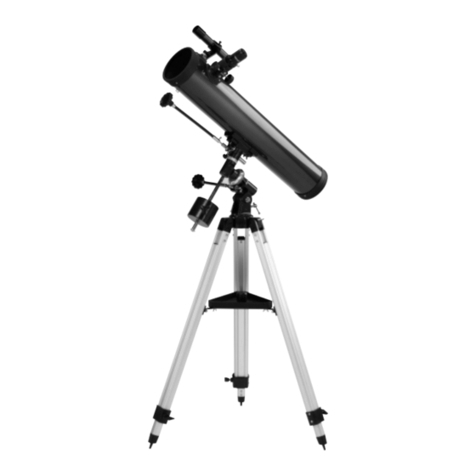
ORION TELESCOPES & BINOCULARS
ORION TELESCOPES & BINOCULARS SpaceProbe 3 EQ 9842 instruction manual

Levenhuk
Levenhuk Ra FT72 ED user manual
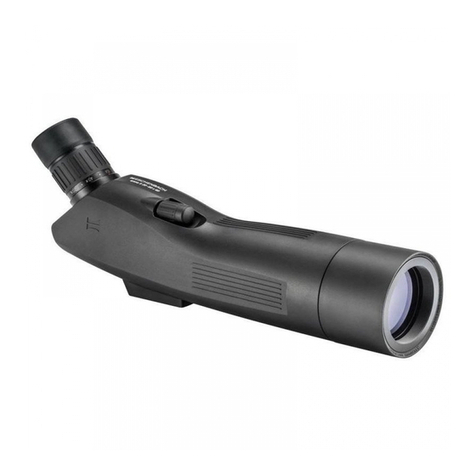
Eschenbach
Eschenbach arena S operating instructions

Meade
Meade ETX-70AT Junior instruction manual
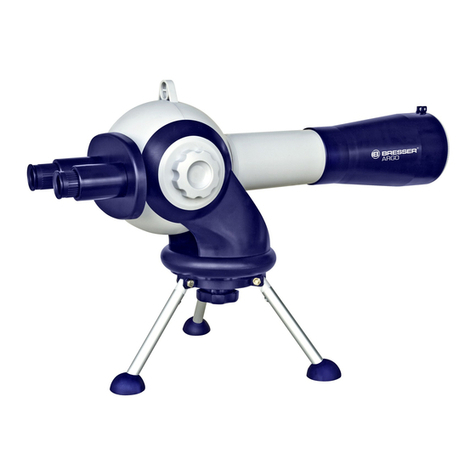
Bresser Junior
Bresser Junior Argo operating instructions
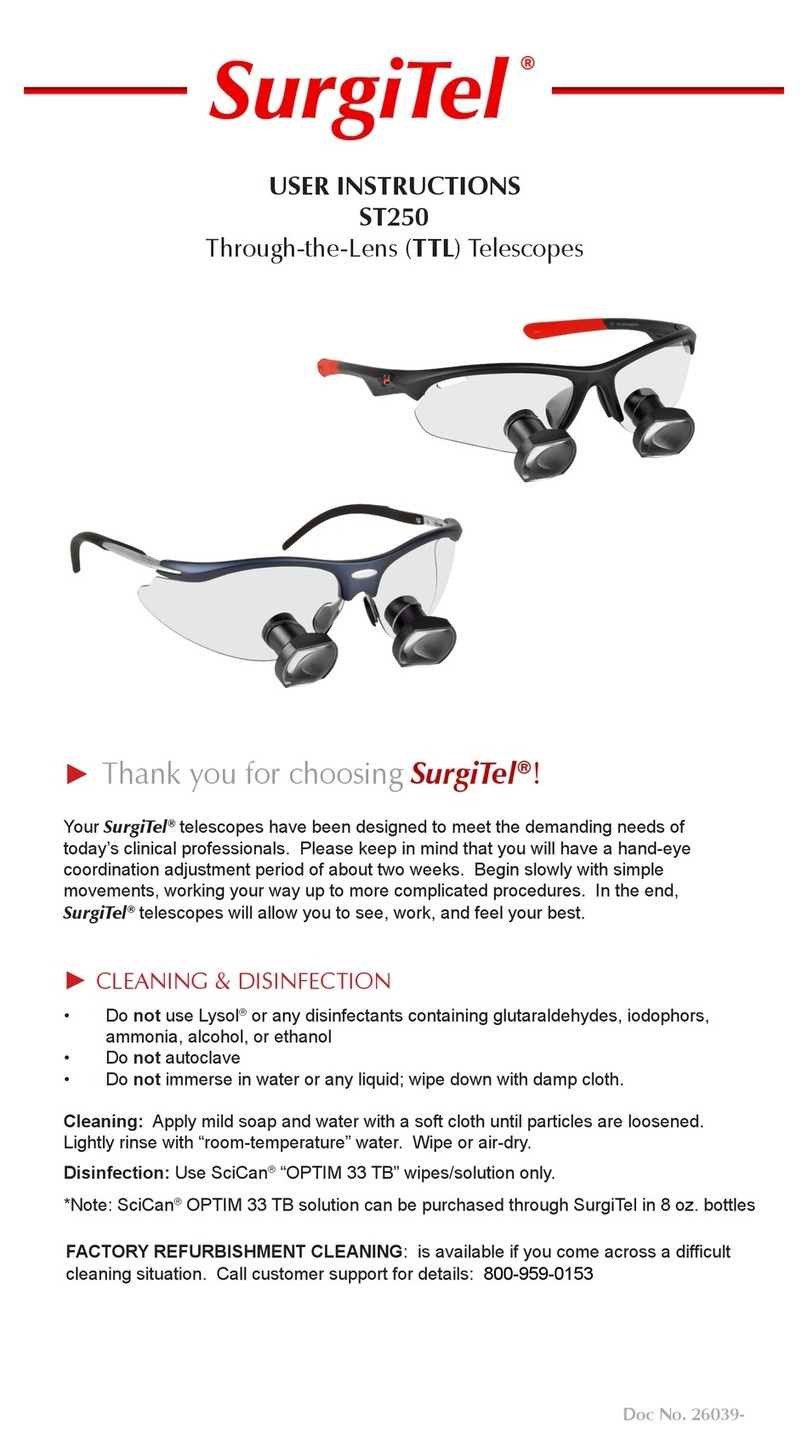
SurgiTel
SurgiTel ST250 User instructions

